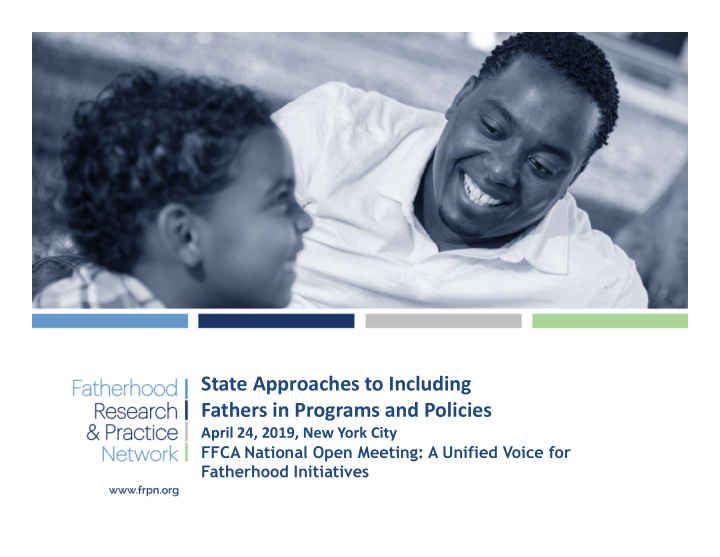



State Approaches to Including Fathers in Programs and Policies April 24, 2019, New York City FFCA National Open Meeting: A Unified Voice for Fatherhood Initiatives
Who is FRPN? Jay Fagan, Ph.D. Temple University FRPN Co-Director Jessica Pearson, Ph.D. Center for Policy Research FRPN Co-Director
Overview of FRPN • Six-year, $4.8 million cooperative agreement to Temple U & CPR • Funding by U.S. DHHS, ACF, Office of Planning, Research and Evaluation, 2013-2019 • Targets fatherhood researchers & programs serving low-income fathers
F atherhood Research And Practice Network #1 #2 #3 Promote Build Disseminate Rigorous Evaluation Information Capacity Evaluation
FRPN State Planning Mini Grants CO Families First Colorado CT State of Connecticut, Department of Social Services KY Lexington Leadership Foundation MI University of Michigan, School of Social Work MN Minnesota Fathers and Families Network NC North Carolina State University, School of Social Work PA The Strong Families Commission RI Parent Support Network of Rhode Island SC South Carolina Center for Fathers and Families WA Washington State Department of Social and Health Services, Economic Services Administration (ESA), Office of the Assistant Secretary WY Wyoming Children’s Trust Fund
Why Focus on State-Level Fatherhood Initiatives? • Father engagement is a serious problem • Few states have sustainable ways of supporting fatherhood initiatives • HMRF grants are time-limited and project specific • Many NCPs don’t pay their child support because of unemployment but fatherhood programs and employment services are not allowable costs for child support agencies • Most employment programs pay no attention to parenting and co- parenting; newer 2-generation initiatives focus on custodial parents and children. • Some states use discretionary TANF funds, IV-D incentive funds, and direct appropriations from state legislatures
Fatherhood Commissions • Ohio, Connecticut, Illinois, Hawaii • Legislatively established in 1999-2003, bi- partisan • Housed in a state government agency w/members across multiple agencies & organizations • Engaged in policy, education, fatherhood services, promotional events, and fundraising for operations • TANF funding (Ohio) • Disbanded in FL and MA, Attempted in 2015 in MN, Strong Families Commission under creation in PA • A permanent organizational “home” for coordinated initiatives to enhance wellbeing of children by providing opportunities to fathers to become better parents, partners and providers
State Initiatives in Human Services Agencies Fathers as economic providers • Model program: Texas NCP Choices • Focus on assessing, providing workforce services and monitoring compliance • Child support, workforce & court collaboration • Court-ordered for delinquent NCPs Fathers as providers, parents & partners • Model program: CSPED • Focus on: case management, workforce services, fatherhood classes, enhanced child support • Staffing by mix of child support staff, workforce personnel & CBOs • Voluntary and court ordered at all stages of case processing
Funding Programs and Services TANF, TANF state maintenance of effort (MOE) • Discretionary TANF funds to promote or sustain marriage, promote responsible parenting and foster economic stability • TANF-ACF-IM 2018: States may use TANF funds to serve NCPs in job programs • In 2016, 20 states used TANF funds for “Fatherhood and Two-Parent Family Programs;” national average of 0.5% of total TANF; many use funds for other two parent-families programs---not fatherhood Child Support Incentive Funds • Regular child support funds cannot be used for NCP job services • Child support incentive funds can be used for job services but funds lower (DRA of 2005) • Only 4 states have obtained waivers from HHS to use incentive funds for job services • OCSE-IM-18-02: States should request a waiver to use incentive funds for NCP work activities Direct legislative appropriation • MN S.F. 1504 appropriated $1.1 million per year for FY 2018-19 to continue FATHER Project to “assist fathers in overcoming barriers” to support their children economically & emotionally
Assessing Program Benefits & ROI • Required report to the legislature on child support payments & self- reported changes in parenting skills by participants (Ohio Commission on Fatherhood) • Annual participant metrics: Child support payments of $646,881, gross earnings of $3 million, total savings and benefits to families & society of $6 million (S.C. Center for Fathers and Families) • Texas NCP Choices returns $8.31 for every $1 spent and saved State of Texas $12 million in SFY 2016 due to: child support collections, employment & earnings, reductions in unemployment insurance claims & avoided TANF & SNAP benefits (Child Support Division of TX OAG) • ROI study for FATHER Project MN documented: Return of $3.41 for every $1 spent for child support, earnings and tax revenue; and $6.06 for every $1 on estimated savings due to reduced criminal activity, paternity establishment, increased child literacy & father engagement in early childhood education (Wilder Research, 2009)
Sustaining Fatherhood Initiatives • Create state-level, multi-agency commissions, councils or advisory boards with explicit father involvement purpose • Access discretionary TANF funds to support fatherhood entity and fatherhood programs • Include fathers in interventions funded by Family First Prevention Services Act • Include fathers in Two-Gen initiatives • Apply for 1115 waivers through child support with state matching funds (when this option becomes available) • Restructure HMRF grant program to involve annual awards to states to create state-level infrastructure for fatherhood & state grants to providers for services • Explore changing rules about allowable IV-D expenditures
“State Approaches to Father Involvement in Programs and Policies Dealing with Children and Families.” FRPN Brief Jessica Pearson, Ph.D. Director, CPR & Co-Director FRPN May 2018 www.frpn.org FRPN Webinar Recording & Slides May 22, 2018 www.frpn.org/asset/frpn-webinar-state- approaches-including-fathers-in- programs-and-policies
Contact Us • Jay Fagan, PhD, FRPN Co-Director – jfagan@temple.edu, (215) 204-1288 • Jessica Pearson, PhD, FRPN Co-Director – jspearson@centerforpolicyresearch.org, (303) 837-1555
Recommend
More recommend